การเพิ่มประสิทธิภาพในการจับแสงของอุปกรณ์ AWG โดยการเปลี่ยนโครงสร้างของท่อนำคลื่นขาออก
Main Article Content
Abstract
บทคัดย่อ
บทความนี้ได้นำเสนอวิธีเพิ่มประสิทธิภาพในการจับแสงของอุปกรณ์ 1×8 arrayed waveguide grating (AWG) de-multiplexer ที่มีขนาดเล็ก ซึ่งขนาดของอุปกรณ์ AWG ที่ออกแบบมีขนาดเพียงครึ่งเดียวของอุปกรณ์ AWG ตัวต้นแบบ โดยวิธีดังกล่าวประกอบด้วยการเปลี่ยนรูปร่างของท่อนำคลื่นขาออกของอุปกรณ์ AWG จากรูปร่างมาตรฐานให้เป็นรูปร่างสี่เหลี่ยมคางหมูที่มีความกว้างเริ่มต้นของท่อนำคลื่นขาออกเท่ากับ 10 ไมโครเมตร และความกว้างสุดท้ายของท่อนำคลื่นขาออกเท่ากับ 6 ไมโครเมตร หลังจากนั้นผู้วิจัยได้ปรับเลื่อนตำแหน่งของท่อนำคลื่นขาออกให้เข้าไปซ้อนทับบริเวณ free propagation region 2 (FPR2) ด้วยระยะ 155.2 ไมโครเมตร โดยค่าดัชนีหักเหของท่อนำคลื่นขาออกและบริเวณ FPR2 มีค่าเท่ากับ 1.460 และ 1.455 ตามลำดับ จากการออกแบบโครงสร้างของอุปกรณ์ AWG ด้วยวิธีดังกล่าว ทำให้ท่อนำคลื่นขาออกแต่ละท่อมีประสิทธิภาพในการจับแสงสูงขึ้นและยังทำให้สัญญาณแสงที่ไปรบกวนท่อนำคลื่นอื่นๆลดลง ส่งผลให้อุปกรณ์ AWG ที่ได้ออกแบบในงานวิจัยนี้มีค่า insertion loss และค่า crosstalk ต่ำกว่าอุปกรณ์ AWG ที่ได้ออกแบบก่อนหน้านี้ โดยมีค่าเท่ากับ 0.11 dB และ -6.80 dB ตามลำดับ นอกจากนี้อุปกรณ์ AWG ที่ได้ออกแบบนี้ยังมีค่า insertion loss ต่ำกว่าค่าของอุปกรณ์ AWG ตัวต้นแบบซึ่งมีค่า insertion loss เท่ากับ 1.26 dB อีกด้วย
คำสำคัญ : arrayed waveguide grating; ประสิทธิภาพในการจับแสง; ค่าลดทอนของสัญญาณ; ค่าการรบกวนของสัญญาณใกล้เคียง
Abstract
This paper presents a method for enhancing the light trapping efficiency of 1×8 small size arrayed waveguide grating (AWG) de-multiplexer. Furthermore, the size of the AWG remains half of that of a traditional AWG. The method involves replacing a traditional output waveguide structure by a taper structure which has start width 10 µm and end width 6 µm. After that, the output waveguides are shifted to overlap with free propagation region 2 (FPR2) with the proper length 155.2 µm. Here, the refractive indices of output waveguides and FPR2 are 1.460 and 1.455, respectively. Through these improvements, the light trapping efficiency of the output waveguides is built up, and the leakage of light to other output waveguides is also reduced. As a result, the insertion loss and crosstalk of our proposed AWG in this work, which are 0.11 dB and -26.80 dB, are lower than those of our previous work. In addition, the insertion loss of this AWG is also lower than that of the traditional AWG which is 1.26 dB.
Keywords: arrayed waveguide grating; light trapping efficiency; insertion loss; crosstalk


